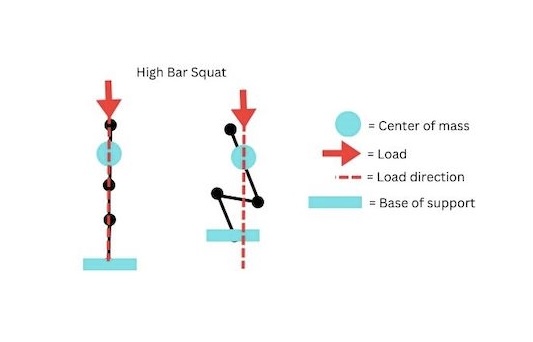The Squat
What is a squat? What are the different kinds of squats? Why do people utilize different variations?
Through this article we’ll dive head first into the squat, keeping it between high bar and low bar for the sake of time and efficiency. We’ll take a look at the mechanics and benefits of both kinds to help you determine the best fit for your training.
First things first, let’s gain an understanding of what a squat actually is. A squat is the vertical translation of the torso well maintaining centre of mass over base of support. That’s the really fancy way of saying we’re going to move our torso vertically well keeping the load (barbell or dumbbell) over the middle of our feet.
Now that we have a basic understanding of what a squat is supposed to be, let’s get into the difference between the two most common squats seen in gyms across the world.
The High Bar Squat
The high bar squat is most relative to the bodybuilding community and trained to perfection by Olympic champions. From a coach’s perspective, there are a few factors that make up a high bar squat shown in the diagram above. So, let’s dig into them a little more in-depth.
The first differentiating factor of the high bar squat is the placement and direction of the load. As you can see from the diagram above, based on where the red arrow and line are pointed in the first figure. We can see that the load is placed pretty vertically, about as close to a line up of the torso as we can get.
The second differentiating factor of this squat variation is the angles of the torso, hips, knees, and ankles. Remember, the goal of the squat is to move our torso vertically well maintaining load (red arrow) and COM (blue circle) over the base of support (blue block).
Because of load positioning, the high bar squat allows us to flex deep into our knees and ankles well maintaining a pretty open hip angle. This can be great for utilizing more quads to move the weight, which makes it a favourite for bodybuilders and Olympians.
The Low Bar Squat
Next up we have the favourite of powerlifters and people looking to squat all the plates in the gym. Just from the digram alone I’m sure you can start to see the differences between the two squats, but fear not because the breakdown is here.
Just like the high bar squat, the first thing that changes here is the load placement and direction of the load. As you can see in Figure one, with a low bar squat the load is further down the back. Opposed to resting on your traps like the high bar variation, the low bar likes to rest right on your rear delts which is significantly lower than your traps.
The second factor will be the angles of the previous joints I mentioned, the torso, hips, knees, ankles, and the joints most involved in moving the load. To compensate for the new placement of load and direction of force, modulate the torso angle so our COM (blue circle) and load (red arrow) still line up somewhere over our centre of mass (blue block).
Due to the changes in joint angles, muscle bias will be a little different versus that of the high bar squat. Because our hip angle has closed off more and our knee angle has opened up more, the muscle recruitment changes. It changes from a more quad-dominant exercise to now a more hip, glute, and lumbar-biased squat.
Which and Why
Now that you understand the mechanics of the two most common squat variations, let’s discuss which one would suit you and why.
The high bar, in my opinion as a coach, will be the most applicable to 99% of the population. Just learning to handle and move one’s centre of mass can be quite the challenge for most people and the high bar squat doesn’t require much modulation of COM. It can be great for the general population and people looking to grow a sick pair of drumsticks at the same time.
However, from my background as a competitive powerlifter, a low bar was my weapon of choice when it comes to squats. If your goal is to be able to move the most weight from point A to B and have a decent ability to control COM, this variation can be quite useful.
As always, thank you for tuning into another installment of educational articles, and thank you for devoting some of your time to reading this.
Any questions regarding anything I covered in this article I would happily answer them in my email or reach out to me on my social media.
Kindest regards, Coach Palfrey





